If it’s possible to feel sorry for inanimate objects, then I feel sorry for windshields. They really can’t win, first they get told to do one thing, then told to do another … it really is no wonder that windshields account for the highest number of suicides amongst outdoor equipment in the UK.
At first sight it probably appears that your windshield only serves one very simple function, that function being to keep the breeze away from your cooker, thus preventing heat loss. If things were that simple then I wouldn’t have any compassion for the humble windshield, I’d just put it straight and tell it to stop moaning. However, just consider, that while your windshield is upholding its end of the bargain and keeping the wind off your stove, it’s also acting as a restrictor … an air restrictor. I’m sure you’re aware that stoves require two primary things in order to function, fuel and air. Too much of one or too little of the other will slow the stove down, reduce efficiency and ultimately prevent it from working at all.
Stoves also require windshields … but all too often we just wrap something round the stove hoping it’ll keep the wind off and don’t give it anymore thought. Even when our stove starts to do things we weren’t expecting or its performance begins to suffer, we continue to ignore the windshield. Perhaps things would be far better if we thought of the windshield and stove as a single package, one working in complete harmony with the other … rather than stove and that bit of old tin foil we found in the bottom draw of the kitchen where all the odd bits of string and old batteries live. The effects of too much ‘air’ reaching your stove are pretty obvious, the flame gets blown about (or out) and most of the precious heat disappears somewhere other than the bottom of your pot. At the other end of the scale, not enough air will also produce very noticeable effects but it’s not always easy for us to see what’s causing them or where the fault lies.
Symptoms of too little air entering the windshield (or not been able to escape it) include – Flame burns yellow. Flame ‘wonders about’ under the pot. Flame becomes much bigger than usual. Base of pot becomes sooty. Boil times increase. Fuel consumption increases. Stove smells of fuel when burning. A flame that ‘pulls’ to one side rather than remaining centred beneath the pot is usually the result of too little air in a localised spot around the stove … it’s often seen when foil, etc is formed into a windshield around 3/4 of the pot with the remaining 1/4 left open.
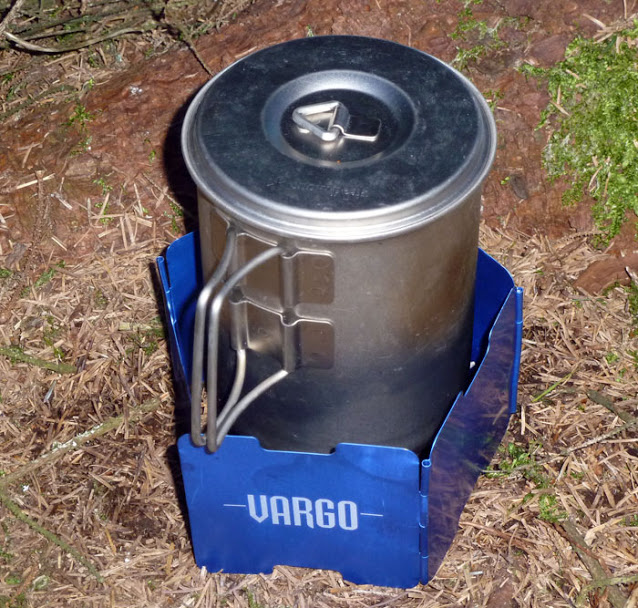 |
| Yes, it’ll keep the wind off … but |
So, your windshield has 2 functions, both of which need to happen simultaneously and both of which seemingly oppose each other. It’s required to form a barrier to the wind and at the same time allow enough air in so the stove can function properly … I told you they had a hard time of things.
Breath In.
Obviously the windshield needs a way of allowing air into the stove and generally speaking the most convenient place for that to happen is near the base of the windshield. Why the bottom? Because firstly that’s where the stove is and secondly, because your stove burns ‘upwards’ it will draw air from around its base … think of it a bit like a chimney.
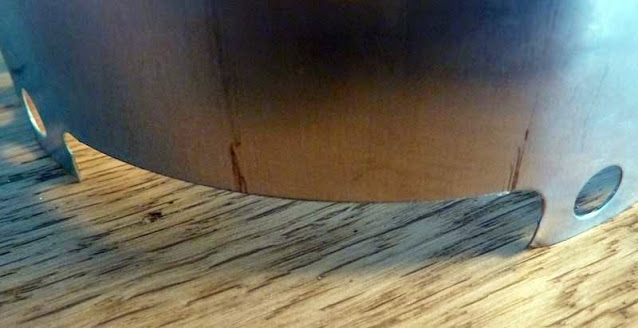 |
| Slots are a pretty easy way to increase air flow. |
As air enters the inner sanctum of our windshield, it would make us very happy if it were calm and slow moving, too much air turbulence will disrupt the flame produced by the stove (just like the wind does, after all wind’s only fast moving air). In a perfect world the windshield would be designed with some sort of internal ‘reservoir’ that would act as a buffer, slowing the incoming air down, stabilising and holding it, then ‘feeding’ it to the stove on demand. Sadly, it’s not a perfect world, so we’ll have to do the best we can and work with what we’ve got and one thing we do potentially have at our disposal is room. If we can make the base of the windshield bigger, we’ll increase the volume, which in turn will produce a little of the ‘reservoir effect’. Another bonus of making the base bigger is that it gives us a greater area from which to get the air outside, inside. It’s impossible to get too much air to the stove, as long as the air isn’t moving around enough to disrupt the flame, then the more the merrier. If you’re making a cylindrical shield, then increasing the diameter at the bottom is obviously going to do the same at the top. As we’ll see in a minute, this might not be a problem but nothing here happens in isolation, every change you make will have a knock on effect somewhere else, there are limits to how big you can go for either practical or performance reasons … so at some point you’ll probably have to compromise.
Breath Out.
If you think of your stove / windshield as an engine with air coming in through the intake, it becomes quite clear that we also need an exhaust to remove the burnt gases … and there’s a lot of them. If these spent gases can’t escape the windshield quickly and easily, they’ll start to restrict the amount of clean air that can enter the windshield, which will stifle the stove. Unless you’re making a shield with some sort of ‘sealed’ top like a cone, then the gap between the outer of your pot and the inner of your shield might suffice as an adequate escape route for the ‘exhaust’ gases … or it might not. I know that’s not very helpful but there’s a lot of factors that can effect things here, if you’re in any doubt, try adding some vent holes / slots around the top, increasing the pot / shield air gap (don’t go too mad) and / or shortening the height of the shield.
As a general guide, you should be trying to build a windshield that in perfect conditions (indoors) appears to have absolutely no effect on how your stove behaves. It can sometimes be a difficult thing to judge especially with a tapered shield or cone but with a little ingenuity you should come up with something that’ll enable you to see what’s going on under there.
Bend me, shape me.
Unsurprisingly, a cylinder is the easiest shape of windshield to make, it’s a fairly convenient shape too as it’ll often roll up and fit inside your pot. However, if you’re really keen, a cone shaped shield will generally increase the stoves efficiency by channeling the (very) hot exhaust gases towards the side of the pot before they’re expelled … and the tapered shape can also increase the velocity of the exhaust gases, which can help draw more fresh air in through the base of the shield … but we’re probably starting to get a bit too complicated here, so I’ll shut up.
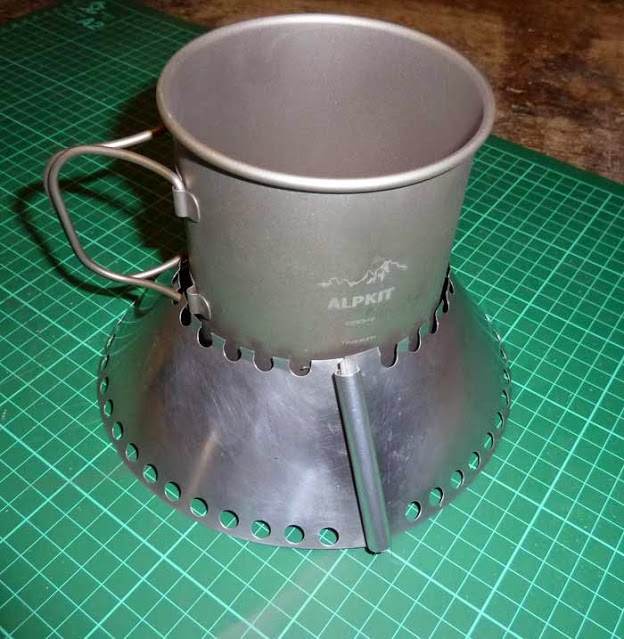 |
| Air in, air out and lots of protection from the wind. |
The biggest problem with cones is actually making them but luckily there are ways of working everything out with bits of string and your best crayons rather than complicated calculations and a degree … so, hopefully this is something we can revisit at a later date with a ‘cones for dummies’ post.
If you like the idea of a cone but feel that your intentions may get mixed up with your abilities when it comes to making one, there are other ways to achieve a similar effect without turning half the worlds sheet aluminium reserves into scrap.
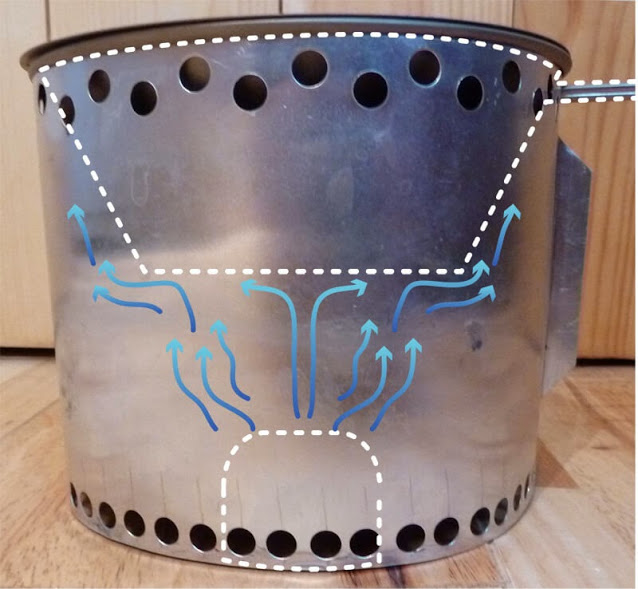 |
| Like a cone stood on its head … sort of. |
The windshield in the above picture was made to be used specifically with a Vargo titanium ‘Sierra Cup’. Due to the pots tapered shape many of the benefits of using a cone are still present … without going to the trouble of actually making one. The stove, windshield and pot work together to produce a very fast and efficeient set up, the shield isn’t an afterthought, it’s just as important as the other two parts.
If you came here expecting a ‘How to make a windshield’ post then I apologise. All this geekery was purely intended to get you thinking … and who knows, maybe even put that bit of tin foil back in the bottom draw with the old batteries. However, I promise a full ‘How to make a windshield’ post will be along shortly. Perhaps I should have said all this at the start … but I didn’t want to put you off.
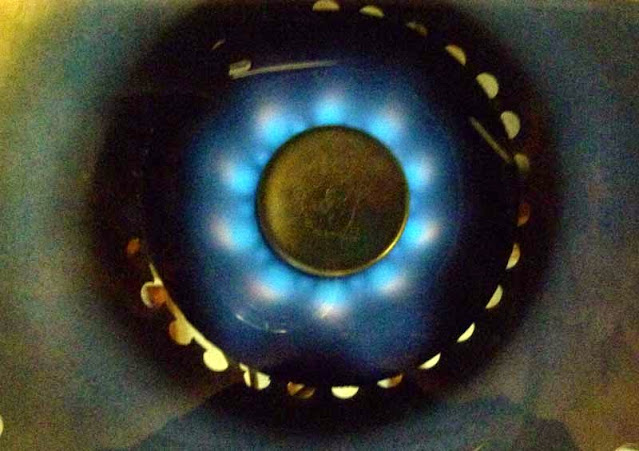

So cone is still best then?
From a performance standpoint then yes, a 'well designed' cone is best but from a practical point of view … not always.
Was thinking about this and in NS saw Kev had a X-Mug type thing which was a collapsible silicon mug. Thought if you turned it upside down and cut a hole in the bottom it would be a great windshield. Maybe the cone ins't the problem but making it out of metal which you can't squish and fold is.
http://www.bouldering.com/media/catalog/product/cache/1/image/9df78eab33525d08d6e5fb8d27136e95/s/e/sea_to_summit_-_x_mug_-_orange_1.jpg
Hole punched silicon cone sounds great but wouldn't be able to double up as a pot stand like the caldera cones.
Are heat exchangers effective,and can one be built into a windshield?
There's a post here somewhere about heat exchangers but the jury's still out at present. I think a series of channels could be formed inside the shield to direct gases up the side of the pot but I imagine a true exchanger might kill the internal air flow.